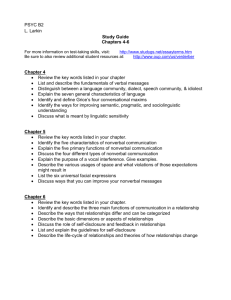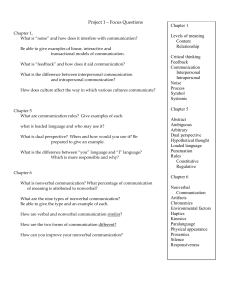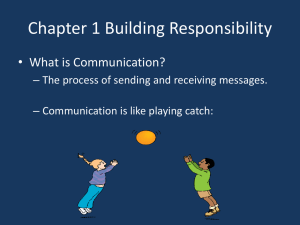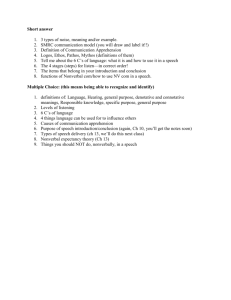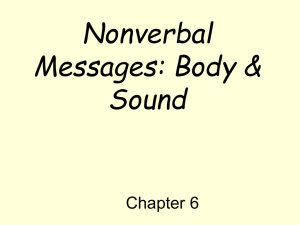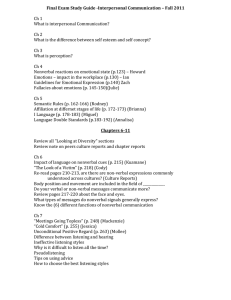Chapter Five
advertisement
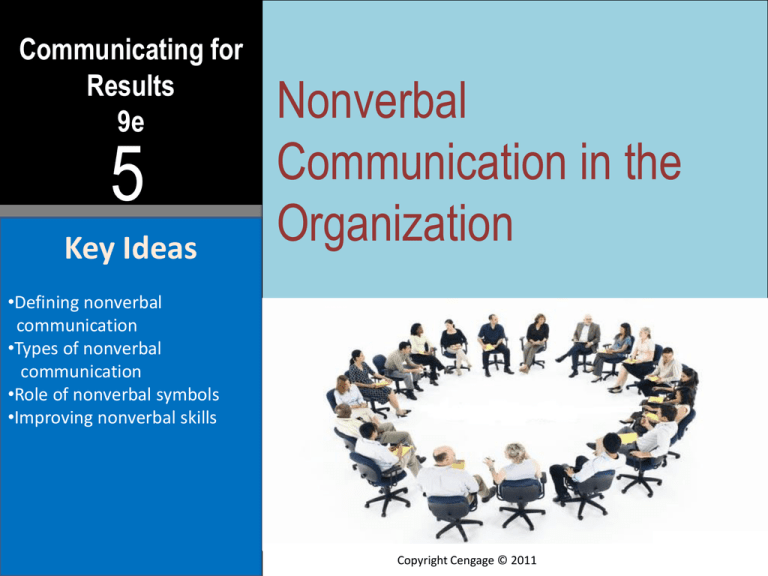
Communicating for Results 9e 5 Key Ideas Nonverbal Communication in the Organization •Defining nonverbal communication •Types of nonverbal communication •Role of nonverbal symbols •Improving nonverbal skills Copyright Cengage © 2011 1 Consider this … Aspects of nonverbal communication make it possible . . . For receivers to be mistaken in interpreting a message, especially if the receiver perceives that message as having been sent on purpose. A shrug meant to convey “I don’t know” may have been interpreted as “I don’t care.” Hickson, Stacks, & Moore, Nonverbal Communication, Roxbury, 2004, p. 15 Copyright Cengage © 2011 2 Non-Verbal Misunderstanding Hook ‘em Horns Case Study Read or describe the case study Answer the following questions: Who was most responsible for the misunderstanding? Which type of gesture best describes the hook ‘em horns sign? How important a role a misunderstanding over a gesture such as this one would play in international affairs. Copyright Cengage © 2011 3 Nonverbal Defined …all intentional and unintentional messages that are not written, spoken, ThinkStock LLC/Index Stock Imagery or sounded. Copyright Cengage © 2011 4 Culture & Nonverbal Behavior Three levels of culture . . . Informal Level—neither rules nor reasons known; behaviors unconsciously learned Copyright Cengage © 2011 NOVA Development Technical Level —Rules are openly and knowingly stated Formal Level—rules known; reasons not known 5 Nonverbal Communication Types include . . . Facial expressions & eye contact Body movements & gestures Clothing & personal appearance Distance & personal space Physical environment Time Copyright Cengage © 2011 6 Facial Expression Face is responsible for most meaning Basic expressions (happiness, surprise, fear) are fairly universal Subtle expressions difficult to interpret Expressions differ across cultures Which face is showing elation? Dread? Fear? Copyright Cengage © 2011 7 Eye Contact In American culture . . . Shows interest and attentiveness Signals wish to participate Controls & persuades others Copyright Cengage © 2011 8 Movements & Gestures Types include . . . Which type of gesture is this Police Officer using? Copyright Cengage © 2011 Ronald Martinez/Getty Images Emblems Illustrators Regulators Adaptors 9 Clothing & Appearance Appropriate business & professional clothing . . . Determines credibility, persuasiveness, status & hiring decisions Affects public perception of organizations Dress-down basics recommended Copyright Cengage © 2011 Christopher Robbins Is problematic (i.e., Casual Confusion Syndrome) 10 Distance & Personal Space Hall’s distance categories . . . Intimate Distance: Contact – 18 inches Copyright Cengage © 2011 11 Distance & Personal Space Hall’s distance categories . . . Intimate Distance: Contact – 18 inches Personal Distance: 18 inches to 4 feet Copyright Cengage © 2011 12 Distance & Personal Space Hall’s distance categories . . . Intimate Distance: Contact to 18 inches Personal Distance: 18 inches to 4 feet Social Distance: 4 to 12 feet Public Distance: 12 Feet or more Copyright Cengage © 2011 13 Physical Environment Reveals the characteristics of the owner Color affects emotional response Lighting and room size alter communication Odor can stir emotions Ergonomics can affect physical well-being Copyright Cengage © 2011 14 Time Most business conducted on informal level Status determines sequences of lateness Time spent signals significance Copyright Cengage © 2011 NOVA Development Perceptions of time depend on cultural background 15 Revising the Case Study What specific types of non-verbal communication could have helped President Bush and the government officials defuse the misunderstanding over Bush’s use of the hook ‘em horns gesture? Copyright Cengage © 2011 16 Nonverbal Status Symbols Include . . . Clothing (i.e., tie & jacket) Darker colors Office size, location, & interior arrangement NOVA Development Powerful nonverbal behaviors Time Gestures What gives this office status? Copyright Cengage © 2011 17 Nonverbal Signs of Power Carr-Ruffino 1997 Expansive, confident movements Tall, upright standing posture Relaxed, affable, familiar behavior Ability to turn one’s back on others Comfortable, relaxed seated positions Copyright Cengage © 2011 18 Nonverbal Signs of Weakness Carr-Ruffino 1997 Small controlled movements Bowed posture; hands covering face Tenseness, vigilance Hesitantly standing or sitting forward Playing with an object or nervous foot or leg shaking Copyright Cengage © 2011 19 Culture Shock And international business transactions . . . International cultures often use unexpected nonverbal symbols and meanings. Result: Culture shock! Copyright Cengage © 2011 AP/Wide World Photos Inadequate training given to expatriates: --65% companies provide no training --40% return home before scheduled time 20 Expectancy Violations Theory According to Burgoon’s theory . . . How people respond when nonverbal expectations are not met Involved all nonverbal behaviors Expectations are violated more when people come from a culture we are not familiar with Copyright Cengage © 2011 21 Immediacy Behaviors “Promoting a feeling of closeness” by . . . Verbal behaviors – humor, personal examples, using “we” & “our” Visual behaviors – smiles, eye contact, relaxed posture, moving around Copyright Cengage © 2011 © Jason Harr is Vocal behaviors – good volume, pitch, & vocal expressiveness 22 Improving Nonverbal Skills Develop awareness of nonverbal differences Do not judge others according to own nonverbal meanings Do not assign nonverbal meanings out of context Observe your nonverbal behavior on videotape or ask others for feedback Copyright Cengage © 2011 23 Communicating for Results 9e 5 Key Ideas Nonverbal Communication in the Organization •Defining nonverbal communication •Types of nonverbal communication •Role of nonverbal symbols •Improving nonverbal skills Copyright Cengage © 2011 24

